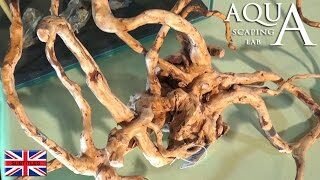 SUBSCRIBE NOW ON YOUTUBE CHANNEL: https://www.youtube.com/c/AquascapingLab
SUBSCRIBE NOW ON YOUTUBE CHANNEL: https://www.youtube.com/c/AquascapingLab
FACEBOOK: https://www.facebook.com/AquascapingLab.info
TWITTER: https://twitter.com/AquascapingLab
INSTAGRAM: https://instagram.com/aquascapinglab/
Aquascaping Lab by Tommasos Perini feat Serena Sacchi present a video tutorial on all types of wood and roots that we can enter into the aquarium. The categories that we use are basically two, those found on the market and those called “do it yourself”.
The first category of wood is composed of:
– WOOD JATI or MANILA: suitable for compositions of plants, very big, brown to reddish, release of humic substances or tannins.
– WOOD NAMIBIA or MOPANI: very dense, variegated colors, suitable for compositions of plants such as Anubias, very rich in tannins and release amber color.
– ROOTS OF JAVA or WOOD SUMATRA: roots of dark color with fine branches and long, suitable for creation of environments for cichlids, little release of humic substances and amber color.
– DRIFTWOOD or MANGROVIA: light colored roots, branches very sinuous and curved almost twisted, very nice aesthetically, suitable for environments with cichlids and recently planted as RYOBOKU.
If you want to enter other kind of woods, driftwood found on the river bed for aesthetic reasons or cost, you should only use these types: BAMBOO (only if dry and treated with special resins) CYPRESS, IVY, BEECH, ALDER (rich in tannins) and OAK.
Remeber that for all types of wood before being introduced into the aquarium, you will have to perform a specific treatment that will sterilize, cancel the eventual flotation and decrease the release of harmful substances such as resins but also the less dangerous as the tannins or humic acids that will color the water of amber yellow and will affect the values of PH GH:
– REMOVE THE BARK
– 1 WEEK SUBMERGED IN A TRAY.
– 3/4 BOILING, DURATION 1 HOUR EACH.
– 1 WEEK SUBMERGED IN A TRAY.
– REPEAT UNTIL REACHING THE OBJECTIVE.
In the case of the appearance of white mold (fluff pile that is formed on the edges) after a few weeks, do not worry, it’s an infestation of bacteria is not harmful for plant or for the animals, then enter fish such as Otocinclus or Ancistrus or Caridina that will eat it, otherwise remove manually,not recommended the use of antibiotics or antibacterial.
ENGLISH:
Aquascaping Lab is a channel dedicated to the world of aquariums, where you can find tutorials, reviews, tips and experiences shared by experts in the field of aquascapinga.The topics covered are:
– Aquascaping in oriental design (Takashi Amano style), various habitats and fitting procedure illustrated by means of tutorials.
Productions of marine aquariums, tropical and Mediterranean.
– Description and sheets of fish crustaceans molluscs invertebrates and corals in saltwater and freshwater.
– Description and data sheets of plants and mosses.
– Review of technical material and products as Askoll Sera, Ehiem, Tetra, JBL, Friskies and others.
– Tips and tricks for starting, cleaning and maintenance of an aquarium: sheets of the materials used.
ITALIANO:
Aquascaping Lab è un canale dedicato al mondo degli acquari dove potrete trovare tutorials, recensioni, consigli ed esperienze condivise da esperti nel campo dell’acquaristica. Gli argomenti trattati sono:
– Aquascaping in design orientale (Takashi Amano style), vari biotopi e procedura di allestimenti illustrati per mezzo di tutorial.
Allestimenti di acquari marini, tropicali e mediterranei.
– Descrizione e schede tecniche di pesci crostacei molluschi invertebrati e coralli di acqua salata e dolce.
– Descrizione e schede tecniche di piante e muschi.
– Recensione su materiale tecnico e prodotti come askoll, sera, ehiem, tetra, Jbl, friskies e altri.
– Trucchi e accorgimenti per l’avvio, la pulizia e la manutenzione di un acquario: schede tecniche sui materiali più usati.
Aquascaping Lab – Aquarium Woods and Roots, Jati, Mopani, Java, Driftwood treatment for amber color